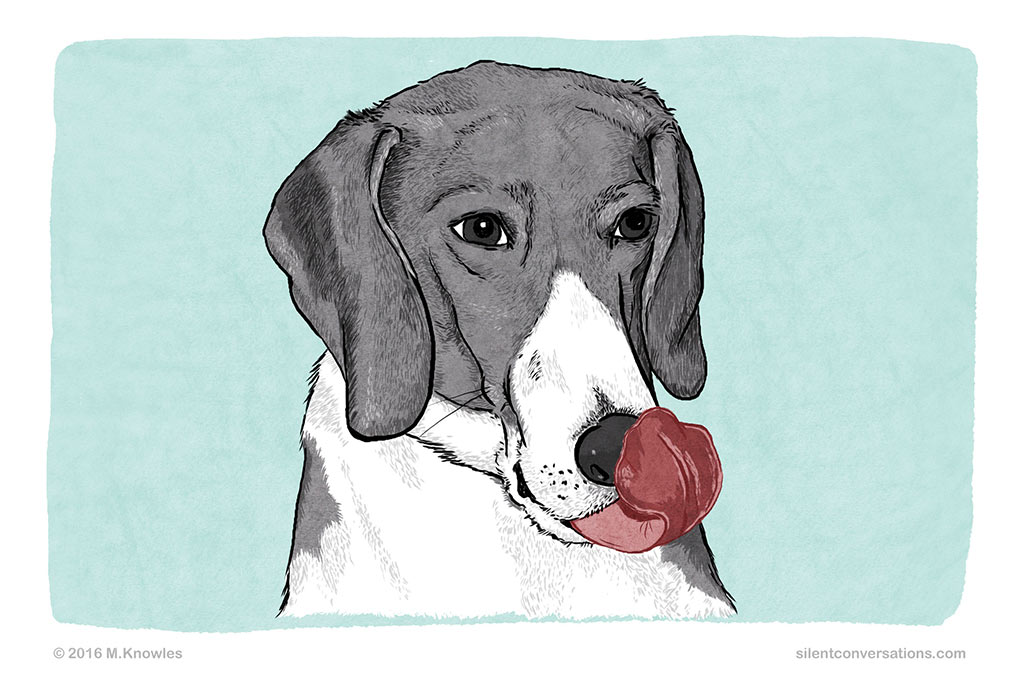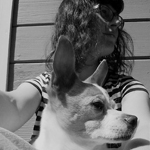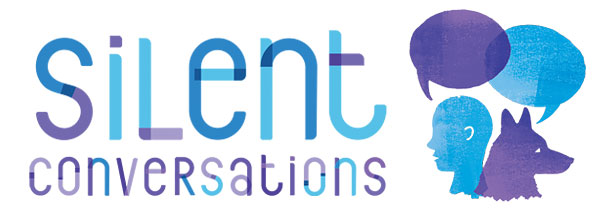
Lip Lick – Dog Body Language
A lip lick can often be seen as a quick tongue flick. From a dog body language perspective, the lip lick could be a calming signal or a sign of stress*, depending on the situation. There is a possibility that the lip lick may be offered unconsciously in the case of stress. The dog may also offer a lip lick deliberately and consciously as a body language signal to calm another party down or to show that it is not feeling comfortable.
Here are a few examples of situations where a dog may offer a lip lick:
- A person leans over a dog to adjust its harness. The dog turns its head to the side and does a quick lip lick. This is to say that the dog is not feeling comfortable with the person leaning over it and invading its space.
- A toddler is sitting near a dog on the floor, waving and making big hand gestures, gurgling and almost grabbing the dog’s face. The dog starts doing lip licks, showing it is feeling uncomfortable and experiencing some stress in the situation. It would be best to manage the situation and give the dog a safe, quiet place away from the toddler.
- A person in a dog training class asks their dog to ‘sit’ in a stern voice. The dog does sit but turns its head away and offers a lip lick to calm the person down, as the speaker’s voice seemed a bit agitated. I have observed many dogs offering lip licks in training class; you would have to observe the dog’s whole body posture, the amount and frequency of signals, and the environment – lip licks in this situation could be due to the environment being busy and stressful, the person’s body language and tone of voice he or she is interacting with, or the dog’s anxiety in figuring out what is expected of it.
- A person comes home to be greeted by an excited dog whose whole body is wagging; the dog’s eyes are squinty, its ears are back, it is sneezing and there are also some lip licks. In this case, the combination of body language and the lip lick might be due to the dog’s excitement.
- A dog is walking in a new environment; the dog’s body movements get faster and more jittery; he scans the environment and starts doing more lip licks. This could mean the dog is a bit unsure and does not feel comfortable in this new environment.
These are just a few examples; there are many more. Start observing to see if you can notice lip licks in other scenarios. As discussed below, interpretations such as the above examples should not be attempted without careful observation and consideration of all aspects of the situation.
What is meant by stress*?
When I mention stress, this does not necessarily imply negative emotion. I mean stress in the physiological sense. So a tongue flick can mean the dog is feeling some sort of emotional discourse. This discourse could range from positive to negative emotion. Both excitement and fear could have similar effects on the body, with various hormones being released and activating the sympathetic nervous system. The dog may be feeling uncomfortable/fearful or it could also be excited about something. When analyzing stress in body language, it is worth noting the frequency and intensity of the various body language signals.
A few notes to consider when observing dog body language
Observation before interpretation
Interpretations should be offered only once you have observed the complete interaction and taken note of the wider picture. To offer an unbiased interpretation of the body language, observe and take note of the situation, taking into account the dog’s whole body, the body language signals, and environment first before offering an interpretation. List all the body language you see in the order that it occurs; try to be as descriptive as possible without adding any emotional language. For instance, saying a dog looks happy is not descriptive and would be seen as an interpretation rather than an observation.
You could, however, list what you observe: ears to the side, eyes almond shaped, slight shortening of the eye, mouth open, long lips, tongue out, body moving loosely, body facing side-on, tail wagging at a slow even pace at body level.
From the observation, I could interpret that the dog seems relaxed or comfortable. I still prefer to say relaxed rather than happy, as I feel you will truly never know exactly what the dog may be feeling on the inside emotionally. It is quite likely the dog may be feeling happy, but I prefer to comment on how the dog is behaving in response to the situation rather than presuming internal emotional states.
The importance of viewing body language within context
Interpretations can vary depending on the context. It is possible for certain body language to be used in different contexts and have subtle differences in meaning within those contexts. Individual body language signals should not be observed in isolation; the wider picture should be considered. Take note of what the dog’s body as a whole is saying. Keep in mind each dog is an individual with varying skills and experiences. What may be typical for one individual may not be for another. In order to observe body language in context, consider the following: the situation, body language signals, the body language expressed by all parts of the dog’s body, environment, and individuals involved. It is worth noting how the body language changes with feedback from the environment or the other individuals interacting.

Martha Knowles
Author
My vision is to create a community of dog guardians who share their observations and interpretations of their dogs’ silent conversations. Hopefully, these experiences and stories will provide some insight into dog communication, which is often overlooked by the untrained eye because it is unfamiliar to humans. We are accustomed to communicating mainly with sound, so we are not attuned to the silent subtle gestures and body language used by dogs to communicate. If you take the time to observe, you will start to see these 'silent conversations' going on around you. My dream is for dog communication to become common knowledge with all dog guardians and as many people as possible. Surprisingly, there are still some professionals working in various dog-related careers who are uneducated about dog body language. Greater awareness of how dogs communicate will help to provide better understanding and improve the mutual relationship between dogs and humans. This will promote safer interactions between our two species and hopefully remove some of the expectations placed on dogs within human society. I would like dog guardians to feel empowered with their knowledge of dog communication so that they can be their dogs’ advocates and stand up for themselves and their dogs when it really matters.
